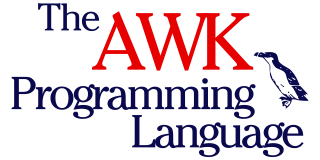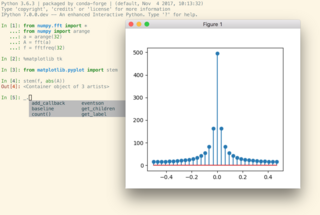
AWK is a domain-specific language designed for text processing and typically used as a data extraction and reporting tool. Like sed and grep, it is a filter, and is a standard feature of most Unix-like operating systems.

KornShell (ksh) is a Unix shell which was developed by David Korn at Bell Labs in the early 1980s and announced at USENIX on July 14, 1983. The initial development was based on Bourne shell source code. Other early contributors were Bell Labs developers Mike Veach and Pat Sullivan, who wrote the Emacs and vi-style line editing modes' code, respectively. KornShell is backward-compatible with the Bourne shell and includes many features of the C shell, inspired by the requests of Bell Labs users.

A Unix shell is a command-line interpreter or shell that provides a command line user interface for Unix-like operating systems. The shell is both an interactive command language and a scripting language, and is used by the operating system to control the execution of the system using shell scripts.

The cd command, also known as chdir, is a command-line shell command used to change the current working directory in various operating systems. It can be used in shell scripts and batch files.

D, also known as dlang, is a multi-paradigm system programming language created by Walter Bright at Digital Mars and released in 2001. Andrei Alexandrescu joined the design and development effort in 2007. Though it originated as a re-engineering of C++, D is a profoundly different language — features of D can be considered streamlined and expanded-upon ideas from C++, however D also draws inspiration from other high-level programming languages, notably Java, Python, Ruby, C#, and Eiffel.
A path is a string of characters used to uniquely identify a location in a directory structure. It is composed by following the directory tree hierarchy in which components, separated by a delimiting character, represent each directory. The delimiting character is most commonly the slash ("/"), the backslash character ("\"), or colon (":"), though some operating systems may use a different delimiter. Paths are used extensively in computer science to represent the directory/file relationships common in modern operating systems and are essential in the construction of Uniform Resource Locators (URLs). Resources can be represented by either absolute or relative paths.
In computer programming, glob patterns specify sets of filenames with wildcard characters. For example, the Unix Bash shell command mv *.txttextfiles/ moves all files with names ending in .txt from the current directory to the directory textfiles. Here, * is a wildcard and *.txt is a glob pattern. The wildcard * stands for "any string of any length including empty, but excluding the path separator characters ".

DIGITAL Command Language (DCL) is the standard command language adopted by many of the operating systems created by Digital Equipment Corporation. DCL had its roots in IAS, TOPS-20, and RT-11 and was implemented as a standard across most of Digital's operating systems, notably RSX-11 and RSTS/E, but took its most powerful form in VAX/VMS. DCL continues to be developed by VSI as part of OpenVMS.

Unified Extensible Firmware Interface is a specification that defines the architecture of the platform firmware used for booting the computer hardware and its interface for interaction with the operating system. Examples of firmware that implement the specification are AMI Aptio, Phoenix SecureCore, TianoCore EDK II, InsydeH2O. UEFI replaces the BIOS which was present in the boot ROM of all personal computers that are IBM PC compatible, although it can provide backwards compatibility with the BIOS using CSM booting. Intel developed the original Extensible Firmware Interface (EFI) specification. Some of the EFI's practices and data formats mirror those of Microsoft Windows. In 2005, UEFI deprecated EFI 1.10.

A command shell is a command-line interface to interact with and manipulate a computer's operating system.
This article provides basic comparisons for notable text editors. More feature details for text editors are available from the Category of text editor features and from the individual products' articles. This article may not be up-to-date or necessarily all-inclusive.

newLISP is a scripting language which is a dialect of the Lisp family of programming languages. It was designed and developed by Lutz Mueller. Because of its small resource requirements, newLISP is excellent for embedded systems applications. Most of the functions you will ever need are already built in. This includes networking functions, support for distributed and multicore processing, and Bayesian statistics. newLISP is free and open-source software released under the GNU General Public License, version 3 or later.
A read–eval–print loop (REPL), also termed an interactive toplevel or language shell, is a simple interactive computer programming environment that takes single user inputs, executes them, and returns the result to the user; a program written in a REPL environment is executed piecewise. The term usually refers to programming interfaces similar to the classic Lisp machine interactive environment. Common examples include command-line shells and similar environments for programming languages, and the technique is very characteristic of scripting languages.

In computing, alias is a command in various command-line interpreters (shells), which enables a replacement of a word by another string. It is mainly used for abbreviating a system command, or for adding default arguments to a regularly used command. alias is available in Unix shells, AmigaDOS, 4DOS/4NT, KolibriOS, Windows PowerShell, ReactOS, and the EFI shell. Aliasing functionality in the MS-DOS and Microsoft Windows operating systems is provided by the DOSKey command-line utility.

IPython is a command shell for interactive computing in multiple programming languages, originally developed for the Python programming language, that offers introspection, rich media, shell syntax, tab completion, and history. IPython provides the following features:
Judoscript is a general purpose programming language designed primarily for scripting tasks on the Java platform. It was conceived and developed by James Jianbo Huang, starting in late 2001. Judoscript was one of the first so-called Java scripting languages; but its most striking characteristics is its audacious multi-domain support philosophy and practice.
A batch file is a script file in DOS, OS/2 and Microsoft Windows. It consists of a series of commands to be executed by the command-line interpreter, stored in a plain text file. A batch file may contain any command the interpreter accepts interactively and use constructs that enable conditional branching and looping within the batch file, such as IF, FOR, and GOTO labels. The term "batch" is from batch processing, meaning "non-interactive execution", though a batch file might not process a batch of multiple data.

A command-line interface (CLI) is a means of interacting with a computer program by inputting lines of text called command-lines. Command-line interfaces emerged in the mid-1960s, on computer terminals, as a user-friendly alternative to punched cards.
The following outline is provided as an overview of and topical guide to the Perl programming language:












